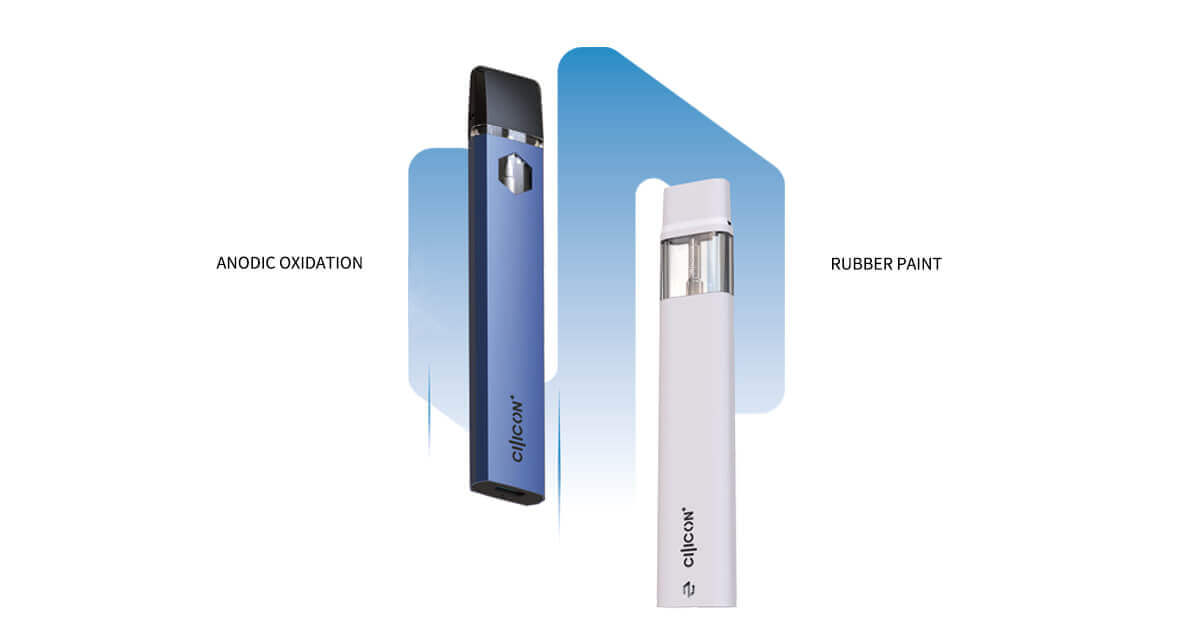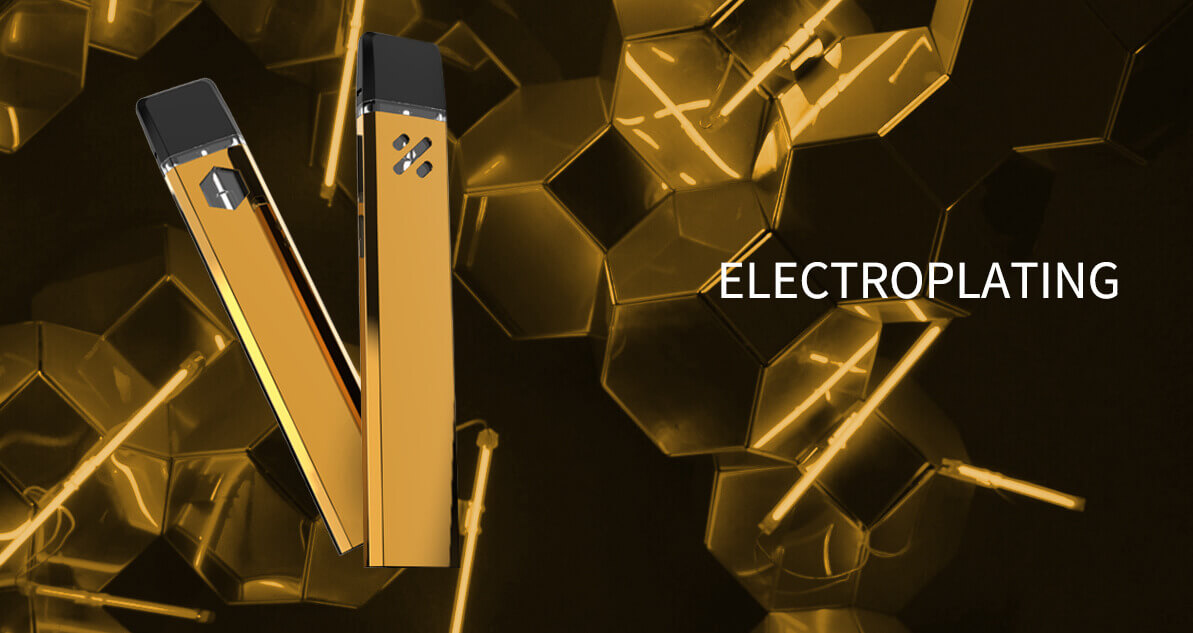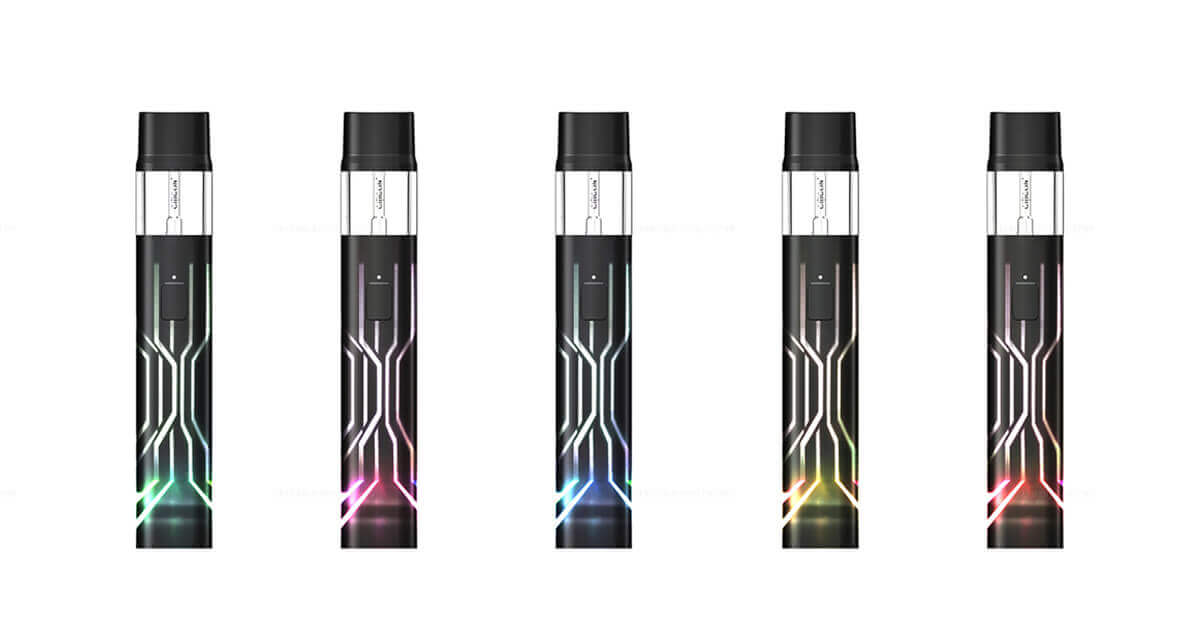Many cannabis vaporizers manufacturers focus on Color, Material, and Finish (CMF) in developing their products. Like other industries, each manufacturer chooses a different CMF to showcase its brand identity. This CMF trend is especially thriving in sectors that produce homogenous goods, such as cannabis vaporizers. A lack of differentiation between one cannabis vaporizer and another urges the manufacturers to find an approach to make their products stand out.
Differentiation issues are incredibly taxing in the 510 threaded vaporizer category as it is the most widespread type of vape. Cannabis vapers can even mix and match the cartridge and battery from different brands so long as they have the ten-thread setups. Thus, CMF could be one of the most important and noticeable differentiators between brands or products.
In this article, Cilicon analyzed the CMF data of 200 cannabis vaporizers brands to curate the top 5 surface finish selections in the market. The data includes cannabis vaporizer brands from California, Nevada, Washington, and Colorado, as well as our existing clients’ data provided by our Chief CMF Officer, Tylor Zhou. Cilicon aims to turn this article into a solid reference for cannabis vaporizer companies before launching their products. We only demonstrate these five types of surface finish because they create the most unique build and feel for cannabis vaporizers. It also has high color accuracy and could be superimposed with multiple patterns.
Cilicon defines an excellent surface finish as being able to serve its purpose in adding value to the product’s quality. In terms of customer’s experience, the cannabis vaporizer’s surface finish is expected to increase corrosion resistance, help with the adhesion of paint and other coatings, eliminate surface defects, increase the resistance of chemicals, improve conductivity, add surface electrical conduction, increase strength and wear resistance while minimizing frictions, also enhance the aesthetical aspect. Moreover, it should also reproduce colors with high accuracy or even superimposed with multiple patterns.
Top 5 Cannabis Vaporizer Surface Finish
Each type of surface finish has its characteristics to consider when manufacturers decide to implement it in their cannabis vaporizer design. Cilicon is here to guide you through the perks and downsides of each surface finish material.
1. Coating
Since 2016, the standard cannabis vaporizers in the market have usually come in a stainless-steel housing. The most popular finishing method for the housing surface is coating, specifically powder coating, which is the modernized type of painting. It uses an electrostatic charge to attract powder particles to cover the surface evenly with minimal waste. Then, the coated surface will go through a heat treatment with ultraviolet lights to speed up the coating process, which will increase production efficiency for the manufacturers. Coating is also a quick surface finish option for many other industries, especially those that produce metal products like vehicle body panels or bike frames.
Rubber paint has been the most used type of coating in the cannabis vaporizer industry. So, why is it so popular? Apparently, many cannabis vapers prefer the skin-like texture of the rubber paint coating finish as it is pleasant and soft to the touch. Rubber paint can be used in any cannabis vaporizer category, including 510 threaded vapes, disposables, all-in-one vaporizers, and pod vapes. However, if the rubber paint option is unavailable, the manufacturers can revert to other coating types such as PU paint (more rugged but with the same skin-like texture as rubber paint), matte paint, and UV paint.
Advantages of Coating
- Low-cost Surface Treatment
Coating is the cheapest surface treatment compared to other methods that will be discussed in this article. The reasons are its simplistic process and relatively high demand. With its implementation across different metal products manufacturing industries, the coating market should offer competitive pricing. Particularly in the cannabis vaporizer industry, coating is even more affordable due to its typically large production scale.
Coating offers a scratch-resistance cannabis vaporizer’s surface. Durability is one of the most crucial product qualities to maintain consumers’ experience and lengthen its useful lifespan.
Disadvantages of Coating
- Because of the high-temperature process, soft materials, such as TPU and silicon, could not be used in coating surface treatment.
- The electroplating surface finishing method could still offer a higher surface protection level than coating.
2. Anodic Oxidation
Anodic oxidation has acquired popularity among cannabis vaporizer companies. In fact, this surface treatment is implemented by one of the pod vapes brand leaders, Stiiizy. To add to the list, some other recognized cannabis vaporizer brands, like Pax and Vessel, also go down the same path.

So, what is anodic oxidation? The treatment is called anodizing, in which the surface is exfoliated with oxidizing acid. The objective is to stimulate the formation of a uniform and continuous oxide finish on the surface (Runge, 2020). There are two popular anodic oxidation treatment types. First, mirror anodizing is the normal oxidation process after polishing the surface. Meanwhile, sandblasting utilizes compressed air to blast abrasive material, like steel sand, brown corundum, etc.) to the surface. Depending on the particle size of the material, each surface finish will have a different texture.
Advantages of Anodic Oxidation
- The ability to control the anodization process and material allows manufacturers to find the right surface texture.
- The most durable surface finish without any scratch concerns.
- The anodization process also affects the inside surface of the cannabis vaporizer.
- The cost is still relatively affordable even though it is not the cheapest option available.
Disadvantages of Anodic Oxidation
- This surface treatment has limited color options as it draws from the base metal color (PHOS, n.d.).
- Concerning the first point, the feel in hand is not as comfortable as coated surface due to the coldness of the metal base.
3. Electroplating
Electroplating is a widely popular surface treatment in the cannabis vaporizer industry, especially for companies that want their products to have an eye-catchy glossy surface finish. The electroplating process involves passing a positively charged electrical current by submerging the surface in a solution containing specific metal ions and a negatively charged electrical current through the plated surface (Anoplate Corporation, n.d.).

The Advantages of Electroplating
- An electroplated surface of cannabis vaporizers will retain its color and glossy finish for a lengthy period, especially compared to the surface treated with the regular coating treatment.
- An electroplated surface also has corrosion resistance. The susceptibility to corrosion is one of the essential factors to evaluate the performance of a cannabis vaporizer for day-to-day uses.
- Electroplating surface treatment creates a delicate metallic texture, which looks dazzling and smooth to the touch.
The Disadvantages of Electroplating
- The downside of its delicate and glossy finish is that it is prone to scratches. Cannabis vapers often store their cannabis vaporizers together with sharp objects, like door keys, which may damage the electroplated cannabis vaporizer surface when they come in contact.
- Electroplating is the costliest compared to the other four types of surface finish mentioned in this article. The reason is that it has low productivity due to its timely process and inconsistent surface finish results. For instance, Apple can only use around 45% of the electroplated phone shells from their supplier after a quality check.
- Fingerprint and sweat are the significant issues that bug the beauty of the electroplated cannabis vaporizer surface. Especially in locations that experience extremely low temperatures, like Miami, it is much easier to leave unwanted prints on the cold surface coming from the consumer’s warm hands.
- Despite its ability to retain colors, the electroplating surface treatment could not bring white paint to the surface due to its chemical attribution.
Cilicon’s Chief CMF Officer recommends cannabis vaporizer companies always stay ahead with budget calculation when choosing the right surface finish for their products. Due to its relatively high cost, he suggested an electroplated surface finish only to be applied on premium products. Another tip of advice is to educate these exclusive customers on how to properly store and use their electroplated cannabis vaporizers to avoid scratches or damages for the longest. Cilicon believes the longer the product’s lifespan, the more consumers will trust our brand.
4. Water Transfer Printing
Water transfer printing has recently gained popularity in the cannabis vaporizer industry. The ability to apply printed designs to three-dimensional surfaces highlights the aesthetic product aspect. Cannabis vaporizers business owners may recall this surface treatment with other names like immersion printing, hydro dipping, water marbling, cubic printing, and hydro-graphics. The process involves submerging the cannabis vaporizer surface coated, which has been coated with an adhesive, into water. Not just any water, it should contain a water-soluble film inked with the desired patterns that will be activated by a specific chemical substance (Rojas, 2016).

The Advantages of Water Transfer Printing
- Accentuate the design aspect with its three-dimensional effect on the surface.
- The ability to showcase diverse patterns that can be turned into a unique selling point of a cannabis vaporizer brand.
- The surface treatment process is compatible with irregular shape cannabis vaporizers.
The Advantages of Water Transfer Printing
- The cost per surface treatment is high, especially for the manufacturers that still endure all manualized processes. This surface treatment may be subjected to a lower manufacturing consistency and productivity.
- The water transfer printing process does not particularly enforce the protective aspect. As a result, the surface finish has a lower abrasive resistance than other discussed surface treatments.
5. 3D Printing
3D printing, often called additive manufacturing, has gradually developed for the past decades. As it is named, this printing technique turns digital files into three-dimensional objects. The manufacturers have different materials to choose to build the object, such as ABS (Acrylonitrile Butadiene Styrene), PLA (Polylactic Acid), wood fibers, ferromagnetic filament, and so on (Wassong, 2019). Based on these characteristics, 3D printing can build any object, including cannabis vaporizer shells with a selection of colors and finishes.
The Advantages of 3D Printing
- It has a low cost per printing of cannabis vaporizers shells.
- The 3D printing produced a surface with a high degree of color reduction, which accommodated the printing machine’s limited color palette.
- The 3D printing techniques allow the designer to create textures with unique haptic experiences for the cannabis vapers (Reiner, n.d.).
The Disadvantages of 3D Printing
- The surface finish has a rougher detail and feels on the hands than other types discussed above.
- Due to the transformation from digital files, the cannabis vaporizer surface result may have a lower design precision.
- The 3D print result is usually tenuous, making it relatively more fragile.
Overall Surface Finishes Comparison
In the table below, Cilicon ranks the crictical aspects for each surface finish discussed in this article, with 1 (one) as the surface finish with superior quality in the particular area.
| Criteria |
Coating |
Anodic Oxidation |
Electroplating |
Water Transfer Printing |
3D Printing |
| Cost |
3 |
1 |
5 |
4 |
2 |
| Color Richness |
3 |
4 |
5 |
1 |
2 |
| Comfort Level |
1 |
2 |
3 |
4 |
5 |
| Visual |
5 |
4 |
3 |
2 |
1 |
| Water Resistance |
2 |
1 |
3 |
4 |
5 |


